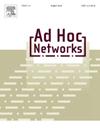A schedulability-aware routing algorithm for time sensitive network based on improved ant colony algorithm
IF 4.4
3区 计算机科学
Q1 COMPUTER SCIENCE, INFORMATION SYSTEMS
引用次数: 0
Abstract
With the rapid development of industrial automation, there are higher requirements for reliable and deterministic communication in industrial networks, including in-vehicle networks, avionics and intelligent transport. Time Sensitive Network offers bounded, low-latency transmission assurance for crucial traffic via the Time Aware Shaper described in the IEEE 802.1Qbv. This standard ensures low jitter and deterministic delay for time-sensitive traffic by employing a pre-calculated circular transmission schedule. Current scheduling algorithms typically use the shortest path algorithm to determine paths for time-triggered flows. However, this approach can lead to an excessive concentration of time-triggered flows traversing the same link, thereby impacting the scheduling feasibility of such flows. In this paper, first, the time-sensitive network topology and time-triggered flows are modeled and the SMT-based no-wait scheduling constraints are proposed. Then, a schedulability-aware routing (SAR) algorithm based on the improved ant colony algorithm is designed to enhance the schedulability of time-triggered flows under the no-wait scheduling problem, thereby improving the ability of the time-sensitive network to accommodate time-triggered flows. Finally, SAR is compared with four routing algorithms including the shortest path routing algorithm (Dijkstra) to evaluate its performance under different network loads. The results show a significant improvement in the scheduling success rate of SAR compared to other routing algorithms. In the original network topology, when the link communication rate is 1000 Mbit/s, SAR achieves scheduling success rates that are 44 %, 62 %, and 56 % higher than Dijkstra for 80, 85, and 90 time-triggered flows, respectively, and 18 %, 8 %, and 10 % higher than LBR.
基于改进蚁群算法的时间敏感网络调度感知路由算法
随着工业自动化的快速发展,包括车载网络、航空电子和智能交通在内的工业网络对通信的可靠性和确定性提出了更高的要求。时间敏感网络通过IEEE 802.1Qbv中描述的时间感知整形器为关键流量提供有限的低延迟传输保证。该标准通过采用预先计算的循环传输调度,确保对时间敏感的流量具有低抖动和确定性延迟。当前的调度算法通常使用最短路径算法来确定时间触发流的路径。然而,这种方法可能会导致时间触发的流过于集中,从而影响这些流的调度可行性。本文首先对时间敏感网络拓扑和时间触发流进行建模,提出了基于smt的无等待调度约束。然后,设计了一种基于改进蚁群算法的可调度性感知路由(SAR)算法,增强了无等待调度问题下时间触发流的可调度性,从而提高了时间敏感网络适应时间触发流的能力。最后,将SAR算法与包括Dijkstra算法在内的四种路由算法进行比较,评估其在不同网络负载下的性能。结果表明,与其他路由算法相比,SAR的调度成功率有了显著提高。在原始网络拓扑中,当链路通信速率为1000mbit /s时,对于80、85和90条时间触发流,SAR的调度成功率分别比Dijkstra高44%、62%和56%,比LBR高18%、8%和10%。
本文章由计算机程序翻译,如有差异,请以英文原文为准。
求助全文
约1分钟内获得全文
求助全文
来源期刊

Ad Hoc Networks
工程技术-电信学
CiteScore
10.20
自引率
4.20%
发文量
131
审稿时长
4.8 months
期刊介绍:
The Ad Hoc Networks is an international and archival journal providing a publication vehicle for complete coverage of all topics of interest to those involved in ad hoc and sensor networking areas. The Ad Hoc Networks considers original, high quality and unpublished contributions addressing all aspects of ad hoc and sensor networks. Specific areas of interest include, but are not limited to:
Mobile and Wireless Ad Hoc Networks
Sensor Networks
Wireless Local and Personal Area Networks
Home Networks
Ad Hoc Networks of Autonomous Intelligent Systems
Novel Architectures for Ad Hoc and Sensor Networks
Self-organizing Network Architectures and Protocols
Transport Layer Protocols
Routing protocols (unicast, multicast, geocast, etc.)
Media Access Control Techniques
Error Control Schemes
Power-Aware, Low-Power and Energy-Efficient Designs
Synchronization and Scheduling Issues
Mobility Management
Mobility-Tolerant Communication Protocols
Location Tracking and Location-based Services
Resource and Information Management
Security and Fault-Tolerance Issues
Hardware and Software Platforms, Systems, and Testbeds
Experimental and Prototype Results
Quality-of-Service Issues
Cross-Layer Interactions
Scalability Issues
Performance Analysis and Simulation of Protocols.
 求助内容:
求助内容: 应助结果提醒方式:
应助结果提醒方式:


